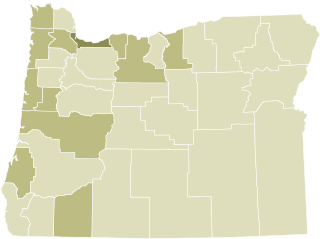Related Research Articles
Measure 28 was a ballot measure, referred by the legislature of the U.S. state of Oregon in 2003. It would have created a temporary one-percent increase in Oregon's income tax. The tax was proposed as a way to overcome deficits to the state budget. The measure was defeated in the January 28, 2003 special election with 575,846 votes in favor, 676,312 votes against.
Measure 16 of 1994 established the U.S. state of Oregon's Death with Dignity Act, which legalizes medical aid in dying with certain restrictions. Passage of this initiative made Oregon the first U.S. state and one of the first jurisdictions in the world to permit some terminally ill patients to determine the time of their own death.
The Oregon tax revolt is a political movement in Oregon which advocates for lower taxes. This movement is part of a larger anti-tax movement in the western United States which began with the enactment of Proposition 13 in California. The tax revolt, carried out in large part by a series of citizens' initiatives and referendums, has reshaped the debate about taxes and public services in Oregon.

In California, a ballot proposition is a referendum or an initiative measure that is submitted to the electorate for a direct decision or direct vote. If passed, it can alter one or more of the articles of the Constitution of California, one or more of the 29 California Codes, or another law in the California Statutes by clarifying current or adding statute(s) or removing current statute(s).

The U.S. state of Oregon established vote-by-mail as the standard mechanism for voting with Ballot Measure 60, a citizen's initiative, in 1998. The measure made Oregon the first state in the United States to conduct its elections exclusively by mail. The measure passed on November 3, 1998, by a margin of 69.4% to 30.6%. Political scientists say Oregon's vote by mail system contributes to its highest-in-the-nation rate of voter turnout, at 61.5% of eligible voters.

Bill Sizemore is an American political activist and writer in Redmond, Oregon, United States. Sizemore has never held elected office, but has nonetheless been a major political figure in Oregon since the 1990s. He is considered one of the main proponents of the Oregon tax revolt, a movement that seeks to reduce taxes in the state. Oregon Taxpayers United, a political action committee he founded in 1993, has advanced numerous ballot initiatives limiting taxation, and has opposed spending initiatives. Sizemore made an unsuccessful run for Governor of Oregon in 1998. He also announced his intention to run for governor in 2010, but was indicted by the state on charges of tax evasion. The charges were later amended to failure to file tax returns.

Proposition 218 is an adopted initiative constitutional amendment which revolutionized local and regional government finance and taxation in California. Named the "Right to Vote on Taxes Act," it was sponsored by the Howard Jarvis Taxpayers Association as a constitutional follow-up to the landmark property tax reduction initiative constitutional amendment, Proposition 13, approved in June 1978. Proposition 218 was approved and adopted by California voters during the November 5, 1996, statewide general election.

Oregon ballot measure 48 was one of two unsuccessful ballot measures sponsored by the Taxpayers Association of Oregon (TAO) on the November 7, 2006 general election ballot. Measure 48 was an initiated constitutional amendment ballot measure. Oregon statute currently limits state appropriations to 8% of projected personal income in Oregon. If Governor declares emergency, legislature may exceed current statutory appropriations limit by 60% vote of each house. This measure would have added a constitutional provision limiting any increase in state spending from one biennium to next biennium to the percentage increase in state population, plus inflation, over previous two years. Certain exceptions to limit, including spending of: federal, donated funds; proceeds from selling certain bonds, real property; money to fund emergency funds; money to fund tax, "kicker," other refunds were included in the provisions of the measure. It also would have provided that spending limit may be exceeded by amount approved by two-thirds of each house of legislature and approved by majority of voters voting in general election.

Elections in Oregon are all held using a Vote by Mail (VBM) system. This means that all registered voters receive their ballots via postal delivery and can vote from their homes. A state Voters’ Pamphlet is mailed to every household in Oregon about three weeks before each statewide election. It includes information about each measure and candidate in the upcoming election.

On November 4, 2008, the U.S. state of Oregon held statewide general elections for three statewide offices, both houses of the Oregon Legislative Assembly, and twelve state ballot measures. The primary elections were held on May 20, 2008. Both elections also included national races for President of the US, US Senator, and US House Representatives. Numerous local jurisdictions — cities, counties, and regional government entities — held elections for various local offices and ballot measures on these days as well.
Ballot Measure 25 of 2002 increased Oregon's minimum wage from $6.50 to $6.90 per hour and required an annual increase to compensate for inflation in future years. Inflation is measured by the consumer price index. As of 2015, the minimum wage in Oregon is $9.25 an hour. The measure was approved in the November 5, 2002 general election with 645,016 votes in favor, 611,658 votes against.Itemized Measure Listings, Measure 25 page 17 The measure was placed on the ballot as a result of initiative petition.

Oregon Ballot Measure 58 was an initiated state statute ballot measure sponsored by Bill Sizemore that appeared on the November 4, 2008 general election ballot in Oregon. It was rejected by voters.

Oregon Ballot Measure 59 was an initiated state statute ballot measure sponsored by Bill Sizemore that appeared on the November 4, 2008 general election ballot in Oregon, United States. If it had passed, Oregon would have join Alabama, Iowa, and Louisiana as the only states to allow federal income taxes to be fully deducted on state income tax returns.

Oregon Ballot Measure 56 or House Joint Resolution 15 is a legislatively referred constitutional amendment that enacted law which provides that property tax elections decided at May and November elections will be decided by a majority of voters who are voting in the relevant election. It repealed the double majority requirement passed by the voters in the 1990s via Measures 47 and 50, which requires that, for non-general elections, all bond measures can pass only when a majority of registered voters turn out.

Oregon Ballot Measure 63 was an initiated state statute that appeared on the November 4, 2008 general election ballot in Oregon. It would have allowed homeowners to make improvements costing less than $35,000 to their home/real estate without first obtaining a building permit.
Oregon ballot measures 46 and 47 were two ballot measures presented as a single package to voters; 46 would have amended the Constitution to allow limitations on campaign financing ; and 47 detailed specific limitations. While Measure 47 passed, 46 did not, and the Secretary of State and Attorney General now refuse to enforce Measure 47 despite not having made constitutional challenges in court during cases filed against them to compel enforcement.
Oregon Ballot Measure 44 was brought to the November, 1996 general election in the U.S. state of Oregon by the initiative process. It passed with 55.9% of the vote. With strong backing from Governor John Kitzhaber, PeaceHealth, a hospital in Eugene, teamed with the Oregon Association of Hospital and Health Systems (OAHHS) to bring about the initiative. Measure 44 would raise tobacco taxes in the state. The primary purpose for raising tobacco taxes was to raise money to fund the Oregon Health Plan (OHP). Additionally some of the money from the tobacco tax would go towards programs to prevent tobacco use and educate people about the harmful effects of tobacco, primarily aimed at children. Measure 44 became highly politicized on both sides.

California state elections in 2018 were held on Tuesday, November 6, 2018, with the primary elections being held on June 5, 2018. Voters elected one member to the United States Senate, 53 members to the United States House of Representatives, all eight state constitutional offices, all four members to the Board of Equalization, 20 members to the California State Senate, and all 80 members to the California State Assembly, among other elected offices.

California Proposition 19 (2020), also referred to as Assembly Constitutional Amendment No. 11, is an amendment of the Constitution of California that was narrowly approved by voters in the general election on November 3, 2020, with just over 51% of the vote. The legislation increases the property tax burden on owners of inherited property to provide expanded property tax benefits to homeowners ages 55 years and older, disabled homeowners, and victims of natural disasters, and fund wildfire response. According to the California Legislative Analyst, Proposition 19 is a large net tax increase "of hundreds of millions of dollars per year."
References
- ↑ "Official Results, State Measure No. 47, November 5, 1996, General Election". Oregon State Elections Division . Retrieved 2008-05-16.
- ↑ "Voting and Voter Registration". Oregon State Elections Division . Retrieved 2008-05-17.
- ↑ "Voters' Pamphlet November 5, 1996 - Measure No. 47: Arguments in Favor". Oregon State Elections Division . Retrieved 2008-05-17.
- ↑ "Property Tax Measure Election Results 1997–2007" (PDF). League of Oregon Cities. Retrieved May 18, 2008.
- ↑ Pitkin, James (March 29, 2007). "The taxman cometh". Willamette Week . Retrieved March 29, 2007.
- ↑ "Editorial: No Dead Voters". Medford Mail-Tribune. 2000. Retrieved 2008-05-17.
- 1 2 Walsh, Ed (June 20, 2007). "Senate Approves 'Double Majority' Change". The Oregonian . Portland, Oregon: Oregonian Media Group. Retrieved May 17, 2008.
- ↑ "Voters' Pamphlet Measures November 2008, page 16 = Measure 56: Arguments in Favor". Oregon State Elections Division . Retrieved 2008-12-19.
- ↑ "Voters' Pamphlet Measures November 2008, page 23 = Measure 56: Arguments in Opposition". Oregon State Elections Division . Retrieved 2008-12-19.
- ↑ Buckstein, Steve (August 22, 2008). "Keep "Double Majority" Voting Rule in Place" . Retrieved 2008-12-19.
- ↑ Voters' Pamphlet Special Election May 20, 1997
- ↑ election results for Measure 50
- ↑ Department of Justice, State of Oregon - Attorney General Opinion Summaries
- ↑ "Voters' Pamphlet Special Election May 20, 1997". Oregon State Elections Division . Retrieved 2008-12-19.